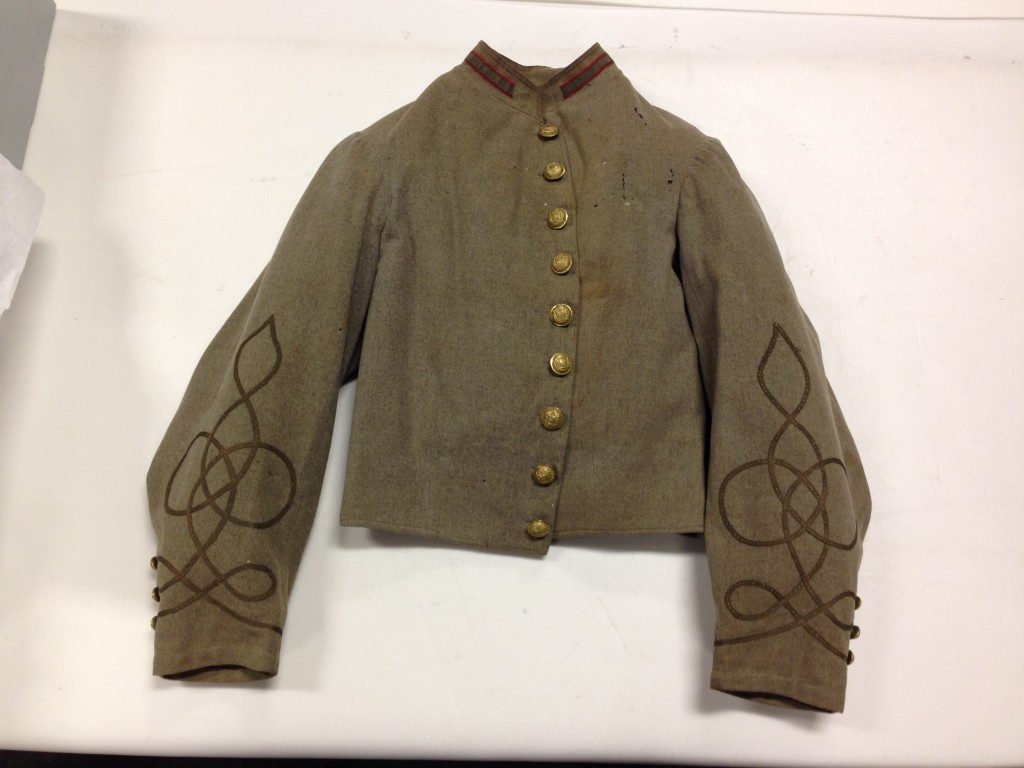Andrew Cross Trippe: Bringing a Uniform to Life
By: Emily Bach
When opening one of the old, deteriorating cardboard boxes inhabiting Pratt House, we are always in awe of what we uncover. At first, our senses immediately begin to observe the garment’s structure, fabric, flaws or previous repairs, and any quirky details that help us narrow down a date for when the costume was worn or constructed. After absorbing the physical traits, we begin to piece together the wearer’s life and bring forth a person’s story through their clothing. As the Pratt House rehousing process resumes this summer, fascinating pieces with spectacular stories have already amazed us. One piece in particular is an artillery man’s civil war jacket that led me to immerse myself in his fascinating life.
On November 29, 1839 in the city of Baltimore, Joseph Everitt and Sarah Patterson Trippe welcomed into the world their newborn son, Andrew Cross Trippe. As Andrew grew up, he attended private schools, gaining an education that enabled him to become a student at Newton University and later graduate from Lafayette College in 1857. Along with a bachelor’s degree from Lafayette College, Andrew furthered his education by earning his master’s degree from the same institution. Before the outbreak of the Civil War, Trippe studied and, at twenty one years of age, was admitted to the bar. Shortly after this grand accomplishment, Trippe volunteered for the North Virginia Army, an army many Marylanders joined who sought to fight for the Confederate States of America rather than the Union. He joined the Second Maryland Company under Captain William H. Murray, beginning his military career.
In May 1863 Trippe advanced to the rank of lieutenant of artillery and ordnance officer, which his shell jacket in our costume collection reveals. Officers wore various insignia to display rank on their uniforms. The following chart provides a visual aid in understanding what each symbol signified in terms of title for a soldier. On Trippe’s jacket’s collar, two single bars of ribbed silk ribbon backed with red wool decorate the front collar. Trippe’s single bar indicate he was Second Lieutenant when he wore this uniform. In addition to this title, we know Cross fought for artillery because the red coloring that borders the bars. Each branch of military (artillery, cavalry, and infantry) received its own color to distinguish one branch from another. Red coloring on one’s uniform indicated a soldier belonged to artillery. Together, the bar and the red wool border titled Trippe as a lieutenant of artillery. Along with analyzing his rank, we can also confirm a date by studying the structure of the jacket. In the early war years, soldiers often started with frock coats, a jacket that fell to a soldier’s knees. As the years wore on and the south withstood blockades initiated by the Union, textile shortages became common, an issue one can see in both men’s and women’s clothing. By 1863, soldiers more commonly wore waist-length jackets to preserve fabric. Andrew Cross Trippe’s jacket falls nicely into this tidbit of history with its length. One’s eyes can also observe the severe sweat rot that the jacket has incurred
Andrew Cross Trippe fought in the Battle of Gettysburg and, on the third day of the battle, he fought at Culp’s Hill. While fighting, Trippe suffered a severe wound in his right shoulder. A three inch piece of shrapnel tore away part of his right shoulder, leading him to enter a vacant house nearby where he was left for dead. He survived his wound, bet was permanently disabled from it. Despite the heavy use of his jacket, it is doubtful Trippe would have worn this jacket in Gettysburg. Records state Trippe decided to join in with his company and fight as a private rather than an officer. One chart lists all those injured and killed in battle along with their rank. Trippe is named as a private. Along with Trippe’s decision to fight alongside his men during this battle, a General Order for Confederate officers in 1862 called for Austrian knots, the gold cord on Trippe’s sleeves, not to be worn during battle because they made officers too conspicuous to enemy combatants. Similar to the collar insignia, Austrian knots signified officer rank. The more elaborate the design, the higher the soldier’s rank. Trippe’s jacket displays these Austrian knots.
Although Trippe most likely did not wear this jacket into Gettysburg, because Trippe’s jacket has incurred sever deterioration from sweat, we can deduce he wore it frequently. As the chemicals from Trippe’s sweat have absorbed into the jacket over the years, the fabric has deteriorated, leaving holes in both the lining and wool. In contrast, Trippe’s frock coat from 1898 has virtually no sweat rot. Andrew Cross Trippe received this coat when he advanced to Major-General, a title that his jacket once again reveals. The collar displays three golden stars semi-encircled by a wreath, a symbol that signifies the title Major-General. As Major-General, Trippe commanded the Maryland division of United Confederate Veterans. Andrew Trippe played a large role in our American and Maryland history through his civilian life as a lawyer and his military life as a soldier. Fortunately, Maryland Historical Society contains a piece of his life in its collection that will help bring his story, and many others, to the public through the costume collection.
……………………………………………………………………………………………………………………………………………………………………………………………………………..
For More Information/Bibliography:
On Andrew Cross Trippe: Hall, Clayton Colman. Baltimore: Its History and Its People. New York: Lewis Historical Pub., 1912. Print.
The Maryland Line: http://www.civilwarhome.com/marylandcmh10.html
The Maryland Line and List of Casualties: http://genealogytrails.com/mary/MDline_chpt9.html


